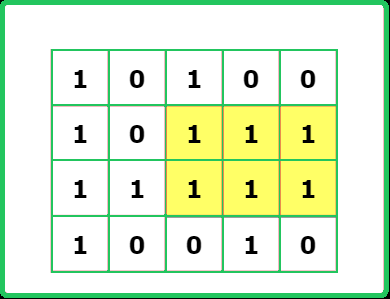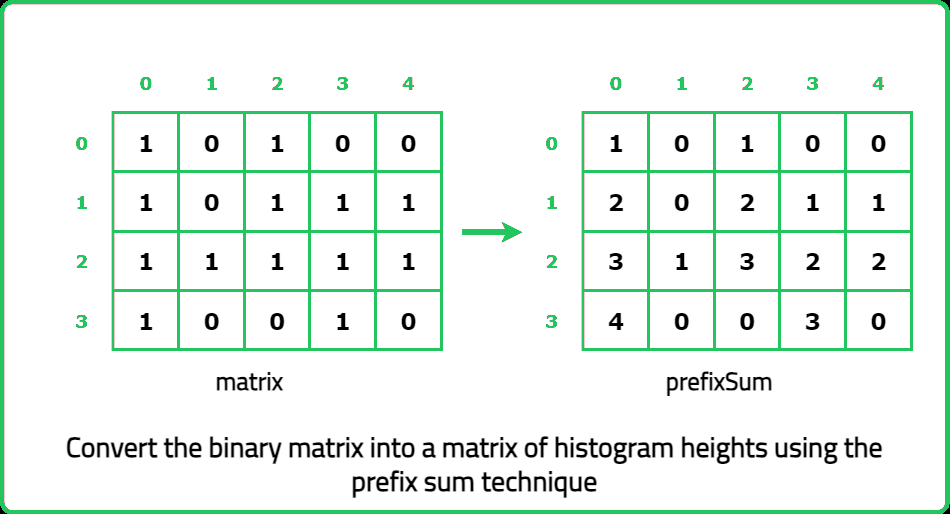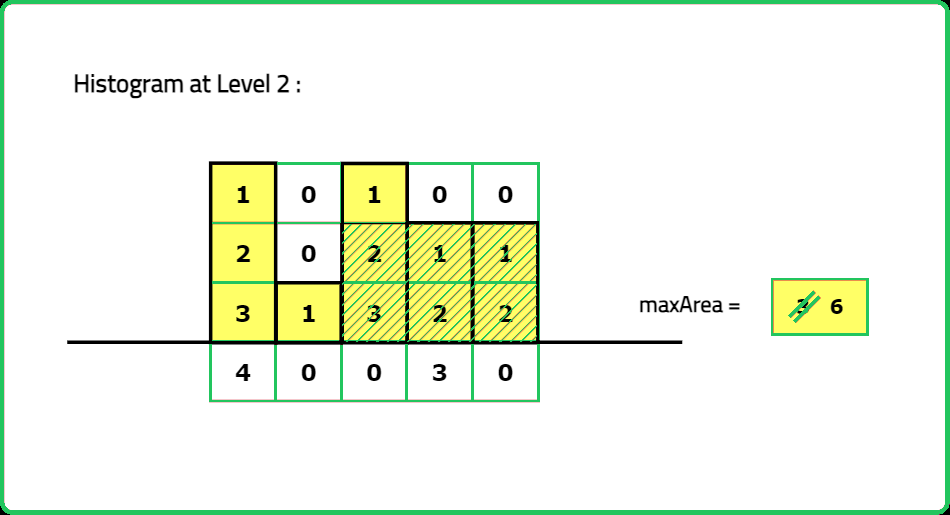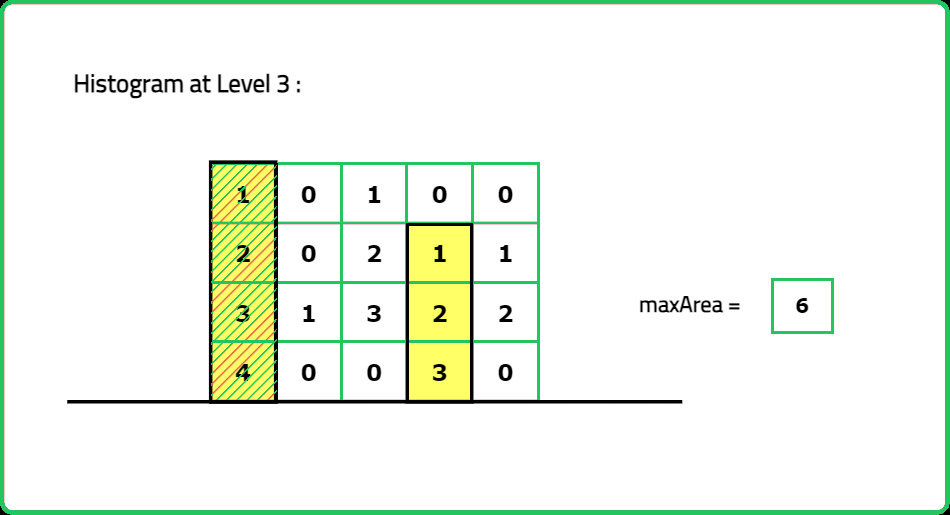123456789101112131415161718192021222324252627282930313233343536373839404142434445464748495051525354555657585960616263646566676869707172737475767778798081828384858687888990919293949596979899100101102103104105106107108109110111112113114115116117118119120121122123124125126127128129130131132133134135136137138139140141142143144145146147148
#include <bits/stdc++.h>
using namespace std;
class Solution {
private:
// Function to find the largest rectangle area
int largestRectangleArea(vector<int> &heights) {
int n = heights.size(); // Size of array
// Stack
stack<int> st;
// To store largest area
int largestArea = 0;
// To store current area
int area;
/* To store the indices of next
and previous smaller elements */
int nse, pse;
// Traverse on the array
for(int i=0; i < n; i++) {
/* Pop the elements in the stack until
the stack is not empty and the top
elements is not the smaller element */
while(!st.empty() &&
heights[st.top()] >= heights[i]){
// Get the index of top of stack
int ind = st.top();
st.pop();
/* Update the index of
previous smaller element */
pse = st.empty() ? -1 : st.top();
/* Next smaller element index for
the popped element is current index */
nse = i;
// Calculate the area of the popped element
area = heights[ind] * (nse-pse-1);
// Update the maximum area
largestArea = max(largestArea, area);
}
// Push the current index in stack
st.push(i);
}
// For elements that are not popped from stack
while(!st.empty()) {
// NSE for such elements is size of array
nse = n;
// Get the index of top of stack
int ind = st.top();
st.pop();
// Update the previous smaller element
pse = st.empty() ? -1 : st.top();
// Calculate the area of the popped element
area = heights[ind] * (nse-pse-1);
// Update the maximum area
largestArea = max(largestArea, area);
}
// Return largest area found
return largestArea;
}
public:
/* Function to find the largest
rectangle area containing all 1s */
int maximalAreaOfSubMatrixOfAll1(vector<vector<int>> &matrix){
// Determine the size of matrix
int n = matrix.size();
int m = matrix[0].size();
/* Prefix sum matric to store heights
for different ground levels */
vector<vector<int>> prefixSum(n, vector<int>(m));
// Fill up the prefix sum matrix column wise
for(int j=0; j < m; j++) {
int sum = 0;
for(int i=0; i < n; i++) {
sum += matrix[i][j];
// If there is no base present
if(matrix[i][j] == 0) {
prefixSum[i][j] = 0;
sum = 0;
}
// Store the height
prefixSum[i][j] = sum;
}
}
// To store the maximum area
int maxArea = 0;
// Traverse for different levels of ground
for(int i = 0; i < n; i++) {
// Get the largest area for current level
int area = largestRectangleArea(prefixSum[i]);
// Update the maximum area
maxArea = max(area, maxArea);
}
// Return the maximum area
return maxArea;
}
};
int main() {
vector<vector<int>> matrix = {
{1, 0, 1, 0, 0},
{1, 0, 1, 1, 1},
{1, 1, 1, 1, 1},
{1, 0, 0, 1, 0}
};
/* Creating an instance of
Solution class */
Solution sol;
/* Function call to find the largest
rectangle area containing all 1s */
int ans =
sol.maximalAreaOfSubMatrixOfAll1(matrix);
cout << "The largest rectangle area containing all 1s is: " << ans;
return 0;
}
123456789101112131415161718192021222324252627282930313233343536373839404142434445464748495051525354555657585960616263646566676869707172737475767778798081828384858687888990919293949596979899100101102103104105106107108109110111112113114115116117118119120121122123124125126127128129130131132133134135136137138139140141142
import java.util.*;
class Solution {
// Function to find the largest rectangle area
private int largestRectangleArea(int[] heights) {
int n = heights.length; // Size of array
// Stack
Stack<Integer> st = new Stack<>();
// To store largest area
int largestArea = 0;
// To store current area
int area;
/* To store the indices of next
and previous smaller elements */
int nse, pse;
// Traverse on the array
for(int i = 0; i < n; i++) {
/* Pop the elements in the stack until
the stack is not empty and the top
elements is not the smaller element */
while(!st.isEmpty() &&
heights[st.peek()] >= heights[i]){
// Get the index of top of stack
int ind = st.pop();
/* Update the index of
previous smaller element */
pse = st.isEmpty() ? -1 : st.peek();
/* Next smaller element index for
the popped element is current index */
nse = i;
// Calculate the area of the popped element
area = heights[ind] * (nse - pse - 1);
// Update the maximum area
largestArea = Math.max(largestArea, area);
}
// Push the current index in stack
st.push(i);
}
// For elements that are not popped from stack
while(!st.isEmpty()) {
// NSE for such elements is size of array
nse = n;
// Get the index of top of stack
int ind = st.pop();
// Update the previous smaller element
pse = st.isEmpty() ? -1 : st.peek();
// Calculate the area of the popped element
area = heights[ind] * (nse - pse - 1);
// Update the maximum area
largestArea = Math.max(largestArea, area);
}
// Return largest area found
return largestArea;
}
/* Function to find the largest
rectangle area containing all 1s */
public int maximalAreaOfSubMatrixOfAll1(int[][] matrix){
// Determine the size of matrix
int n = matrix.length;
int m = matrix[0].length;
/* Prefix sum matric to store heights
for different ground levels */
int[][] prefixSum = new int[n][m];
// Fill up the prefix sum matrix column wise
for(int j = 0; j < m; j++) {
int sum = 0;
for(int i = 0; i < n; i++) {
sum += matrix[i][j];
// If there is no base present
if(matrix[i][j] == 0) {
prefixSum[i][j] = 0;
sum = 0;
} else {
// Store the height
prefixSum[i][j] = sum;
}
}
}
// To store the maximum area
int maxArea = 0;
// Traverse for different levels of ground
for(int i = 0; i < n; i++) {
// Get the largest area for current level
int area = largestRectangleArea(prefixSum[i]);
// Update the maximum area
maxArea = Math.max(area, maxArea);
}
// Return the maximum area
return maxArea;
}
public static void main(String[] args) {
int[][] matrix = {
{1, 0, 1, 0, 0},
{1, 0, 1, 1, 1},
{1, 1, 1, 1, 1},
{1, 0, 0, 1, 0}
};
/* Creating an instance of
Solution class */
Solution sol = new Solution();
/* Function call to find the largest
rectangle area containing all 1s */
int ans = sol.maximalAreaOfSubMatrixOfAll1(matrix);
System.out.println("The largest rectangle area containing all 1s is: " + ans);
}
}
123456789101112131415161718192021222324252627282930313233343536373839404142434445464748495051525354555657585960616263646566676869707172737475767778798081828384858687888990919293949596979899100101102103104105106107108109110111112113114115116117118119120121122123124125126127
class Solution:
# Function to find the largest rectangle area
def largestRectangleArea(self, heights):
n = len(heights) # Size of array
# Stack
st = []
# To store largest area
largestArea = 0
# To store current area
area = 0
# To store the indices of next
# and previous smaller elements
nse, pse = 0, 0
# Traverse on the array
for i in range(n):
# Pop the elements in the stack until
# the stack is not empty and the top
# elements is not the smaller element
while st and heights[st[-1]] >= heights[i]:
# Get the index of top of stack
ind = st.pop()
# Update the index of
# previous smaller element
pse = st[-1] if st else -1
# Next smaller element index for
# the popped element is current index
nse = i
# Calculate the area of the popped element
area = heights[ind] * (nse - pse - 1)
# Update the maximum area
largestArea = max(largestArea, area)
# Push the current index in stack
st.append(i)
# For elements that are not popped from stack
while st:
# NSE for such elements is size of array
nse = n
# Get the index of top of stack
ind = st.pop()
# Update the previous smaller element
pse = st[-1] if st else -1
# Calculate the area of the popped element
area = heights[ind] * (nse - pse - 1)
# Update the maximum area
largestArea = max(largestArea, area)
# Return largest area found
return largestArea
# Function to find the largest
# rectangle area containing all 1s
def maximalAreaOfSubMatrixOfAll1(self, matrix):
# Determine the size of matrix
n = len(matrix)
m = len(matrix[0])
# Prefix sum matric to store heights
# for different ground levels
prefixSum = [[0] * m for _ in range(n)]
# Fill up the prefix sum matrix column wise
for j in range(m):
sum = 0
for i in range(n):
sum += matrix[i][j]
# If there is no base present
if matrix[i][j] == 0:
prefixSum[i][j] = 0
sum = 0
else:
# Store the height
prefixSum[i][j] = sum
# To store the maximum area
maxArea = 0
# Traverse for different levels of ground
for i in range(n):
# Get the largest area for current level
area = self.largestRectangleArea(prefixSum[i])
# Update the maximum area
maxArea = max(area, maxArea)
# Return the maximum area
return maxArea
# Main code
if __name__ == "__main__":
matrix = [
[1, 0, 1, 0, 0],
[1, 0, 1, 1, 1],
[1, 1, 1, 1, 1],
[1, 0, 0, 1, 0]
]
# Creating an instance of Solution class
sol = Solution()
# Function call to find the largest rectangle area containing all 1s
ans = sol.maximalAreaOfSubMatrixOfAll1(matrix)
print("The largest rectangle area containing all 1s is:", ans)
123456789101112131415161718192021222324252627282930313233343536373839404142434445464748495051525354555657585960616263646566676869707172737475767778798081828384858687888990919293949596979899100101102103104105106107108109110111112113114115116117118119120121122123124125126127128129130131132133134135136137138139140141
class Solution {
// Function to find the largest rectangle area
largestRectangleArea(heights) {
const n = heights.length; // Size of array
// Stack
const st = [];
// To store largest area
let largestArea = 0;
// To store current area
let area;
/* To store the indices of next
and previous smaller elements */
let nse, pse;
// Traverse on the array
for(let i = 0; i < n; i++) {
/* Pop the elements in the stack until
the stack is not empty and the top
elements is not the smaller element */
while(st.length &&
heights[st[st.length - 1]] >= heights[i]){
// Get the index of top of stack
const ind = st.pop();
/* Update the index of
previous smaller element */
pse = st.length ? st[st.length - 1] : -1;
/* Next smaller element index for
the popped element is current index */
nse = i;
// Calculate the area of the popped element
area = heights[ind] * (nse - pse - 1);
// Update the maximum area
largestArea = Math.max(largestArea, area);
}
// Push the current index in stack
st.push(i);
}
// For elements that are not popped from stack
while(st.length) {
// NSE for such elements is size of array
nse = n;
// Get the index of top of stack
const ind = st.pop();
// Update the previous smaller element
pse = st.length ? st[st.length - 1] : -1;
// Calculate the area of the popped element
area = heights[ind] * (nse - pse - 1);
// Update the maximum area
largestArea = Math.max(largestArea, area);
}
// Return largest area found
return largestArea;
}
/* Function to find the largest
rectangle area containing all 1s */
maximalAreaOfSubMatrixOfAll1(matrix){
// Determine the size of matrix
const n = matrix.length;
const m = matrix[0].length;
/* Prefix sum matric to store heights
for different ground levels */
const prefixSum = Array.from(
{ length: n },
() => Array(m).fill(0)
);
// Fill up the prefix sum matrix column wise
for(let j = 0; j < m; j++) {
let sum = 0;
for(let i = 0; i < n; i++) {
sum += matrix[i][j];
// If there is no base present
if(matrix[i][j] == 0) {
prefixSum[i][j] = 0;
sum = 0;
} else {
// Store the height
prefixSum[i][j] = sum;
}
}
}
// To store the maximum area
let maxArea = 0;
// Traverse for different levels of ground
for(let i = 0; i < n; i++) {
// Get the largest area for current level
const area = this.largestRectangleArea(prefixSum[i]);
// Update the maximum area
maxArea = Math.max(area, maxArea);
}
// Return the maximum area
return maxArea;
}
}
// Main code
const matrix = [
[1, 0, 1, 0, 0],
[1, 0, 1, 1, 1],
[1, 1, 1, 1, 1],
[1, 0, 0, 1, 0]
];
/* Creating an instance of Solution class */
const sol = new Solution();
/* Function call to find the largest
rectangle area containing all 1s */
const ans = sol.maximalAreaOfSubMatrixOfAll1(matrix);
console.log("The largest rectangle area containing all 1s is:", ans);





